Blog & Latest Updates
Fly Fishing Articles
Insects by Common Name


> > Miscellaneous
Closeup insects from Miscellaneous
Female Siphlonurus quebecensis (Gray Drake) Mayfly Dun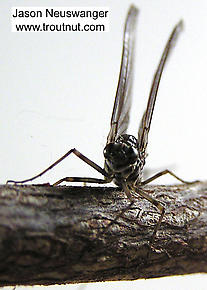 View 3 PicturesThis one hatched in my house after I brought some nymphs home to photograph.
View 3 PicturesThis one hatched in my house after I brought some nymphs home to photograph.
 View 3 PicturesThis one hatched in my house after I brought some nymphs home to photograph.
View 3 PicturesThis one hatched in my house after I brought some nymphs home to photograph.Collected May 18, 2004 from unknown in Wisconsin
Added to Troutnut.com by Troutnut on January 25, 2006
Added to Troutnut.com by Troutnut on January 25, 2006
Taeniopteryx nivalis (Early Black Stonefly) Stonefly Nymph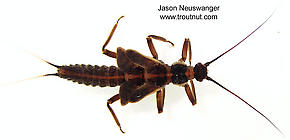 View 2 PicturesI found this nymph wriggling in the surface film during a hatch of related Strophopteryx adults. This nymph died in transport so it's not alive in the photos, but it's pretty close to its live colors.
View 2 PicturesI found this nymph wriggling in the surface film during a hatch of related Strophopteryx adults. This nymph died in transport so it's not alive in the photos, but it's pretty close to its live colors.
 View 2 PicturesI found this nymph wriggling in the surface film during a hatch of related Strophopteryx adults. This nymph died in transport so it's not alive in the photos, but it's pretty close to its live colors.
View 2 PicturesI found this nymph wriggling in the surface film during a hatch of related Strophopteryx adults. This nymph died in transport so it's not alive in the photos, but it's pretty close to its live colors.Collected March 18, 2004 from unknown in Wisconsin
Added to Troutnut.com by Troutnut on January 25, 2006
Added to Troutnut.com by Troutnut on January 25, 2006
Male Ephemerella excrucians (Pale Morning Dun) Mayfly Dun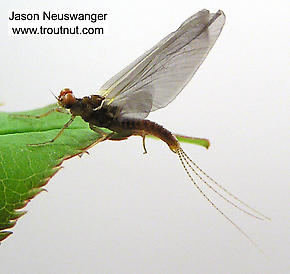 View 3 Pictures
View 3 Pictures
 View 3 Pictures
View 3 PicturesCollected May 22, 2004 from unknown in Wisconsin
Added to Troutnut.com by Troutnut on January 25, 2006
Added to Troutnut.com by Troutnut on January 25, 2006
Calopteryx Damselfly Nymph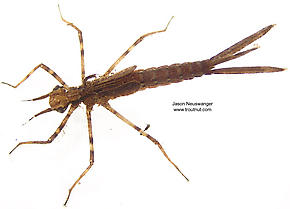 View 2 Pictures
View 2 Pictures
 View 2 Pictures
View 2 PicturesCollected March 1, 2004 from unknown in Wisconsin
Added to Troutnut.com by Troutnut on January 25, 2006
Added to Troutnut.com by Troutnut on January 25, 2006
Strophopteryx fasciata (Mottled Willowfly) Stonefly Nymph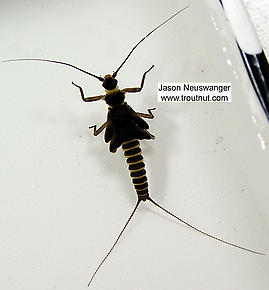 View 2 Pictures
View 2 Pictures
 View 2 Pictures
View 2 PicturesCollected March 10, 2004 from unknown in Wisconsin
Added to Troutnut.com by Troutnut on January 19, 2006
Added to Troutnut.com by Troutnut on January 19, 2006
Female Ephemerella subvaria (Hendrickson) Mayfly Spinner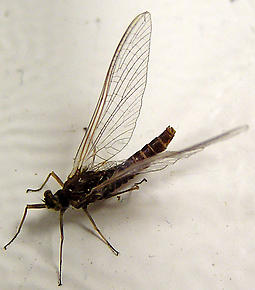 View 3 Pictures
View 3 Pictures
 View 3 Pictures
View 3 PicturesCollected May 19, 2004 from unknown in Wisconsin
Added to Troutnut.com by Troutnut on January 25, 2006
Added to Troutnut.com by Troutnut on January 25, 2006
Aeshnidae Dragonfly Nymph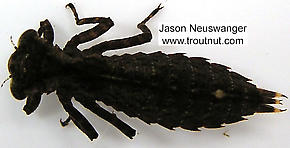 View 2 Pictures
View 2 Pictures
 View 2 Pictures
View 2 PicturesCollected February 2, 2004 from unknown in Wisconsin
Added to Troutnut.com by Troutnut on January 25, 2006
Added to Troutnut.com by Troutnut on January 25, 2006
Chironomidae (Midges) Midge Larva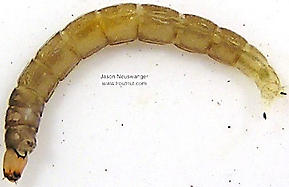 View 2 Pictures
View 2 Pictures
 View 2 Pictures
View 2 PicturesCollected February 5, 2004 from unknown in Wisconsin
Added to Troutnut.com by Troutnut on January 25, 2006
Added to Troutnut.com by Troutnut on January 25, 2006
Baetidae (Blue-Winged Olives) Mayfly Nymph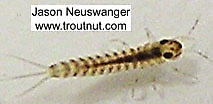 View 2 PicturesHere's a rather different tiny Baetid nymph. The tails are all unbanded, and the tergites (
View 2 PicturesHere's a rather different tiny Baetid nymph. The tails are all unbanded, and the tergites (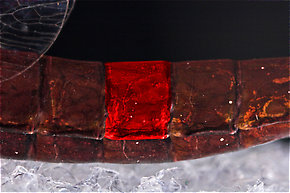 Tergite: The top (dorsal) part of a single segment on an insect's abdomen when it consists of a single chitinous plate (sclerite), or an individual sclerite if the segment has more than one.) all have a dark-colored anterior (Anterior: Toward the front of an organism's body. The phrase "anterior to" means "in front of.") 2/3 and light-colored posterior (Posterior: Toward the back of an organism's body. The phrase "posterior to" means "in back of.") 1/3. The gill veinlets (Veinlet: Short insect wing veins connecting the major longitudinal veins to the wing margin.) are indistinct. It's probably a very early instar (Instar: Many invertebrates molt through dozens of progressively larger and better-developed stages as they grow. Each of these stages is known as an instar. Hard-bodied nymphs typically molt through more instars than soft-bodied larvae.) of some Baetis species.
Tergite: The top (dorsal) part of a single segment on an insect's abdomen when it consists of a single chitinous plate (sclerite), or an individual sclerite if the segment has more than one.) all have a dark-colored anterior (Anterior: Toward the front of an organism's body. The phrase "anterior to" means "in front of.") 2/3 and light-colored posterior (Posterior: Toward the back of an organism's body. The phrase "posterior to" means "in back of.") 1/3. The gill veinlets (Veinlet: Short insect wing veins connecting the major longitudinal veins to the wing margin.) are indistinct. It's probably a very early instar (Instar: Many invertebrates molt through dozens of progressively larger and better-developed stages as they grow. Each of these stages is known as an instar. Hard-bodied nymphs typically molt through more instars than soft-bodied larvae.) of some Baetis species.
 View 2 PicturesHere's a rather different tiny Baetid nymph. The tails are all unbanded, and the tergites (
View 2 PicturesHere's a rather different tiny Baetid nymph. The tails are all unbanded, and the tergites (
One tergite of this Isonychia bicolor mayfly spinner is highlighted in red.
Collected January 31, 2004 from unknown in Wisconsin
Added to Troutnut.com by Troutnut on January 25, 2006
Added to Troutnut.com by Troutnut on January 25, 2006
Ephemerella subvaria (Hendrickson) Mayfly Nymph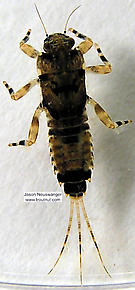 View 3 Pictures
View 3 Pictures
 View 3 Pictures
View 3 PicturesCollected January 12, 2004 from unknown in Wisconsin
Added to Troutnut.com by Troutnut on January 25, 2006
Added to Troutnut.com by Troutnut on January 25, 2006
Start a Discussion of Miscellaneous:
Top 10 Fly Hatches
Top Gift Shop Designs
Eat mayflies.
Top Insect Specimens
Miscellaneous Sites
Troutnut.com is copyright © 2004-2024 Jason
Neuswanger (email Jason). See my FAQ for information about use of my images.
 privacy policy
privacy policy
